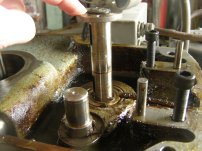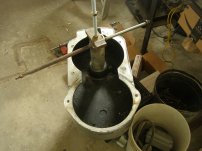Yes, thinking about it, one of my questions was "would the dots stay lined up", and I don't think they would,
This is ancient information from Lumley Spindle Service but maybe that's suitable, these are ancient machines we're talking about ... the dots are for when you have double bearings. They are the high point of runout, so when you have two bearings together, put them lined up so the two bearings aren't fighting each other. If there's only one bearing there's nothing to line them up to, inside and outside of course won't stay lined up, if they do you gots a problem, houston

Yes, I know there is a fine line between too much, and not enough, but not sure where that line is?
Easy enough to look online but I remember about 1/3 of the bearing filled ? No more than that.
These bearings "felt ok", but I had decided to replace all the bearings "as long as I'm here",
I'm absolutely no good at telling if bearings are good or not by feel, so if it is at all important I replace them. Don't listen to me 'cuz nobody with any sense does but in this situation, where it's just the varidrive, not the spindle, I'd go new commercial because my feel is so bad and I would not want to take it apart again.
If I did that I'd want to go sealed.
I think the quill/spindle comes out from the bottom, so don't have to worry about that at this time.
I'm still contemplating getting into the actual spindle bearings, judging by the old hard grease I've seen, they might need some fresh grease, at least to last 20 more years.....
Yeah, I did mine after about two weeks solid of using the mill for a broach, it wasn't that difficult but they are expensive. Again, depending on what you do ? I'm not so sure that quality commercial bearings aren't a better deal than blownup precision bearings. In the varidrive I'd definitely go that way, in the spindle, hmmm. But probably. If you are doing mostly repair work ? Should be okay ?
We probably have something here, ningbo is the bearing capitol of the world, but that's too iffy for some people ?
I don't know about you, but I'm finding some solace in the 20 year schedule, after that it's someone else's problem, LOL.
20 ? It is to laugh

Edit: Info from tub of spindle grease,, PTFE-Lithium Complex, Dropping Point +500F/+260C, NLGI Grade 1, Extreme Pressure Protection. If not the right stuff, please advise.
For grease, again Lumley but they had me using this red colored almost clear stuff, Unbrako or Realslippo or something like that. I am not a big fan of those lithium greases, they dpn't seem to cling or last. The white one is good for engine assembly because it washes right out as soon as the engine has oil pressure but that doesn't seem like what you want in a mill spindle. Recently I was using a red wheel bearing grease that was a lot like the stuff from before, will ask what it was. It was pretty nice.
btw, seems to me if anyone should know about dots/spots, it'd be you.













